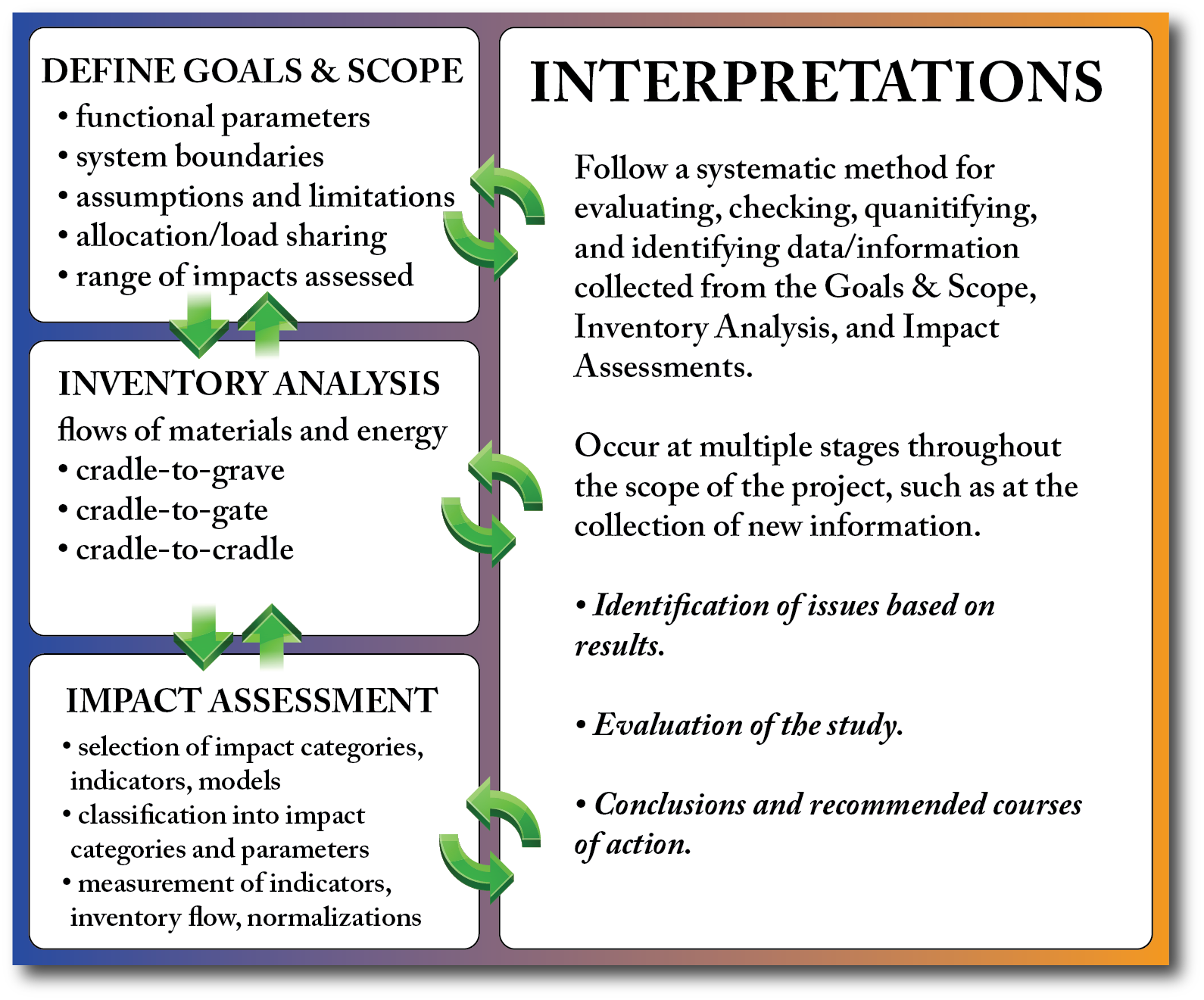5.2 Life Cycle Analysis
Four aspects of a Life Cycle Analysis
The purpose of the LCA process is to determine the entire range of costs, impacts, and externalities for a given project, from the sourcing of raw materials (cradle) to the projected endpoint (grave). The four main processes of the LCA are to define the goals and scope of the LCA; to conduct an inventory analysis; to assess for impacts; and to interpret the results all along the way so as to be able to take necessary steps to cut costs, decrease risks, and lower undesirable impacts.

The Common Elements of a Life-Cycle Analysis graphic has four parts: Define Goals and Scope, Inventory Analysis, Impact Assessment, and Interpretations. In the graphic, each part is shown to be dependent on other parts; the use of arrows indicates flow between those parts. For example:
- The Define Goals and Scope element is linked to the Inventory Analysis element and to the Interpretation of results.
- The Inventory Analysis element is linked to both the Define Goals and Scope element and the Impact Assessment element as well as the Interpretation of results.
- Impact Assessment is linked to Inventory Analysis and interpretation of results
In each section, there are several bullet points
DEFINE GOALS & SCOPE:
- functional parameters
- system boundaries
- assumptions and limitations
- allocation/load sharing
- range of impacts assessed.
INVENTORY ANALYSIS: flows of materials and energy
- cradle-to-grave
- cradle-to-gate
- cradle-to-cradle.
IMPACT ASSESSMENT:
- selection of impact categories, indicators, models
- classification into impact categories and parameters
- measurement of indicators, inventory flow, normalizations.
INTERPRETATIONS: Follow a systematic method for evaluating, checking, quantifying, and identifying data/information collected from the Goals & Scope, Inventory Analysis, and Impact Assessments. Occur at multiple stages throughout the scope of the project, such as at the collection of new information.
- Identification of issues based on results.
- Evaluation of the study.
- Conclusions and recommended courses of action.
The ISO LCA
The LCA framework was standardized in 1997 by the ISO (1997) International organization of standardization and is part of the wider set of ISO 14000 Environmental Standards. This is probably the best overview of an LCA approach available: 1997 Environmental management—life cycle assessment—principles and framework (ISO/FDIS 14040), ISO TC 207. The most recent version of the ISO LCA is ISO 14040:2006, which was last updated in 2010.
LCA Modeling Applications
There are a wide variety of professional software packages (GaBi, SimaPro, Quantis Suite, Sustainable Minds, OpenLCA, etc.) that allow for the analysis of a product's entire life cycle. These software packages allow you to trace every energy, material, and even social input that it takes to bring a product from raw materials to all the way to the end of its functional life, when it is either recycled or dumped.
We will not be engaging with the software in this course, but you need to learn how to read a life-cycle assessment report and understand what it means to make a decision based on those reports. If you are curious and would like to give LCA a try, I recommend playing around with the OpenLCA platform, which is free and open-source. Here are a few sample reports for you to read through from the OpenLCA community:
- OpenLCA Case Study of a Beer Bottle (Alum vs PET)
- Comparison of PET bottles from different sources
- OpenLCA Case Study Social and Environmental Impacts of a T-Shirt
LCA as way of life
The overall trend in design for industrial sustainability, particularly in European countries, has been to further increase the goals and scope of an LCA to be as inclusive as possible of every and all components of a process or a product. LCAs are important to many companies, because LCAs can support their claims of being "sustainably sourced." As such, LCAs are becoming the only way companies can even plan to produce a sustainable design requiring any complex supply chain.
LCIAs, or Life Cycle Impact Assessments, are an emerging category of LCA that tries to focus on all impacts of a specific product, production chain, energy source, etc. A very good introduction to what is covered in the LCIA can be found here. LCIA Methods: Impact Assessment Methods in Life Cycle Analysis.
By no means can we begin to cover the entire range of LCA in this course. Nevertheless, LCA is something you will need to pay greater attention to if you want to leverage that information into a market and/or nonmarket strategy.
